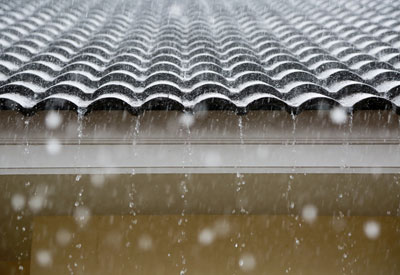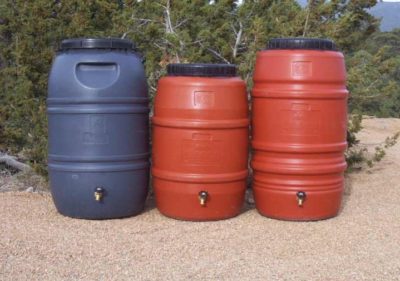
By
Rain water collection and storage systems capture a gift from the sky. They’ve been used for centuries where and when rains are absent. Today, in the face of persistent drought and depleted aquifers, rainwater harvesting makes more sense than ever.
No matter how it’s collected or what it’s used for, utilizing rainwater lessens the pressure on our water supply. Collecting rainwater is appropriate in desert climates with monsoon seasons or infrequent thunderstorms as well as regions with adequate rainfall. Like solar-generated electricity stored in a battery, harvested rainwater is there when you need it.
 Thanks to new filtration and treatment technology, sophisticated rainwater systems are designed to supply the water needs, including drinking water, of entire households. These systems are particularly appropriate to rural dwellers whose wells may be brackish or contaminated by agricultural runoff, and city folk whose municipal water systems draw from polluted sources.
Thanks to new filtration and treatment technology, sophisticated rainwater systems are designed to supply the water needs, including drinking water, of entire households. These systems are particularly appropriate to rural dwellers whose wells may be brackish or contaminated by agricultural runoff, and city folk whose municipal water systems draw from polluted sources.
Here’s a rainwater collection system that’s no-fuss — with a touch of magic. The Rain Wizard 50 gallon rain barrel captures runoff from your roof and stores it for a not-so rainy day. When your garden needs the extra moisture, just hook a hose to the brass spigot.
Most home-harvested water is used to irrigate landscapes. Outdoor use of water, much of which goes to lawns and gardens, accounts for nearly a third of household water used in the United States. The Environmental Protection Agency says that nine billion gallons of water a day (PDF) are devoted to landscape irrigation.
Collection strategies are of two types. Passive systems (PDF) are designed to collect and direct runoff where it’s needed, allowing it to soak into the ground around trees, in irrigation troughs, or in holding ponds that support rain gardens.
Active systems collect and channel rain into holding vessels. These can be as sophisticated as collecting runoff from the roofs of large commercial structures in underground cisterns or as simple as a garbage can placed under a home’s rain gutter. Small improvements on this simple roof-and-barrel method can result in more rainwater collected and better delivery systems.
Houses with existing gutters already have a suitable method of transporting rain water to the ground. Rain barrels with lids that accept standard drain pipe sizes can be fitted under downspouts for maximum collection. Barrels can be connected in a series, at the bottom, to increase capacity.
It’s important to keep your storage barrels covered to prevent mosquito breeding and contamination from birds. Adding a debris screen where the roof’s gutters empty into the drain pipe will help prevent clogging at the spigot level.
That spigot, located at the bottom of the barrel, is where you’ll connect hose or fill watering cans. You can make your own barrel from used 30 or 55 gallon, preferably food-grade barrels that have been thoroughly cleaned. Or use large, plastic trash cans (though these, when filled with water, tend to be flimsy; they’re also difficult to drill).
Better are sturdy, large-capacity barrels designed for rain collection that come fit with inlets, spigots, over-flow valves, and pre-drilled couplings so that your barrels can be connected to increase storage capacity. Some have screw-down lids that ensure a tight seal. Others have designer features — planter space atop a vase-shaped, high-capacity container — that add something to the landscape. A plus: Some of these barrels are made from recycled materials.
It goes without saying that you’ll want to position your barrels under the downspout closest to where you’ll be using the water. This may mean barrels in the front of the house for irrigating flower beds and whatever water-wise plantings you’ve made to replace your lawn, and barrels in the back where your vegetable garden and fruit trees reside.
Either way, you’ll want those barrels off the ground. The higher the barrels are above ground level, the better access and water pressure you’ll have when attaching a hose. The common solution is to lay a foundation of concrete blocks that lifts your barrels high enough to get a watering can under the spigot. Platforms for the barrels can also be built, raising the barrels to waist high, but these need to be made extra sturdy and dependable. 55 gallons of water weighs 458 pounds.
Ambitious gardening types have connected rain barrels to drip and automatic irrigation systems in a further effort to conserve the precious resource they collect.
Strong, safe and sophisticated! he Rain Wizard Urn combines a svelte design with tough, hardworking features like a generous capacity, a clever overflow channel, a brass hose connector and a screen to keep out debris, insects and curious kids.
Deciding how much holding capacity or how many barrels you’ll need in your system depends on how much you can collect and the weather conditions at the time you’ll most need it. Climate charts can be helpful here.
How much rainwater can you collect? The University of Arizona Cooperative Extension says that an inch of rain on one square foot of catchment surface yields 0.6 gallon of water. That means that 500 square feet of collection surface, say half your modest home’s pitched roof, would yield over 300 gallons of water in a good downpour.
Modern, sustainable home design frequently incorporates water harvesting in its plans. It’s not uncommon in the desert southwest to see large, silo structures of 300 gallons and more next to homes built with water collection in mind. Some contemporary designs are absolutely stunning in their collection and use of rainwater.
When you incorporate harvested rainwater into your landscape, you avoid pulling down your municipal water supplies by spraying their chemically treated water all over your garden. In other words, you’re doing something good for both your neighbors and the environment. And, yes, you’ll save money.
Surprisingly, water rights issues in some western states have limited or curtailed the harvesting of rainwater. It’s wise to check your state and county’s regulations concerning rainwater — especially if you live in Utah, Washington, Colorado, and California — for the latest regulations and guidelines. States that allow rainwater collection, and that’s most of them, often have building codes (PDF) that address collection systems.
Here’s some helpful background (and encouragement!) from the University of Arizona’s cooperative extension system. And here’s the gateway to Texas A&M’s rather comprehensive web pages on rainwater. Now, does anybody know the words to the song “Pennies From Heaven”?
